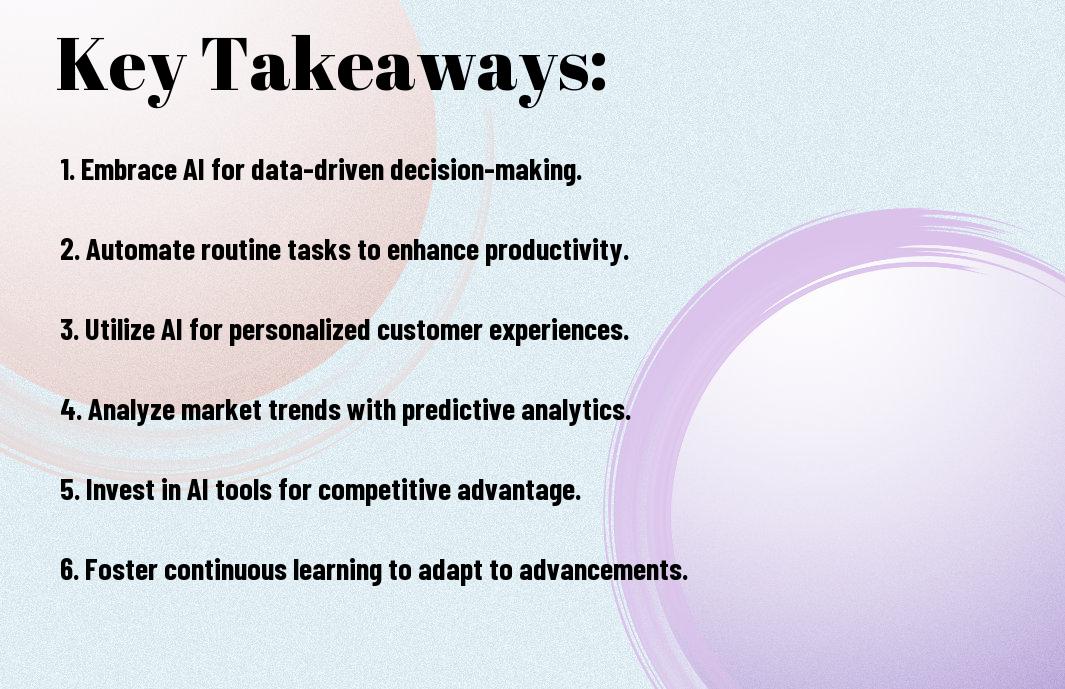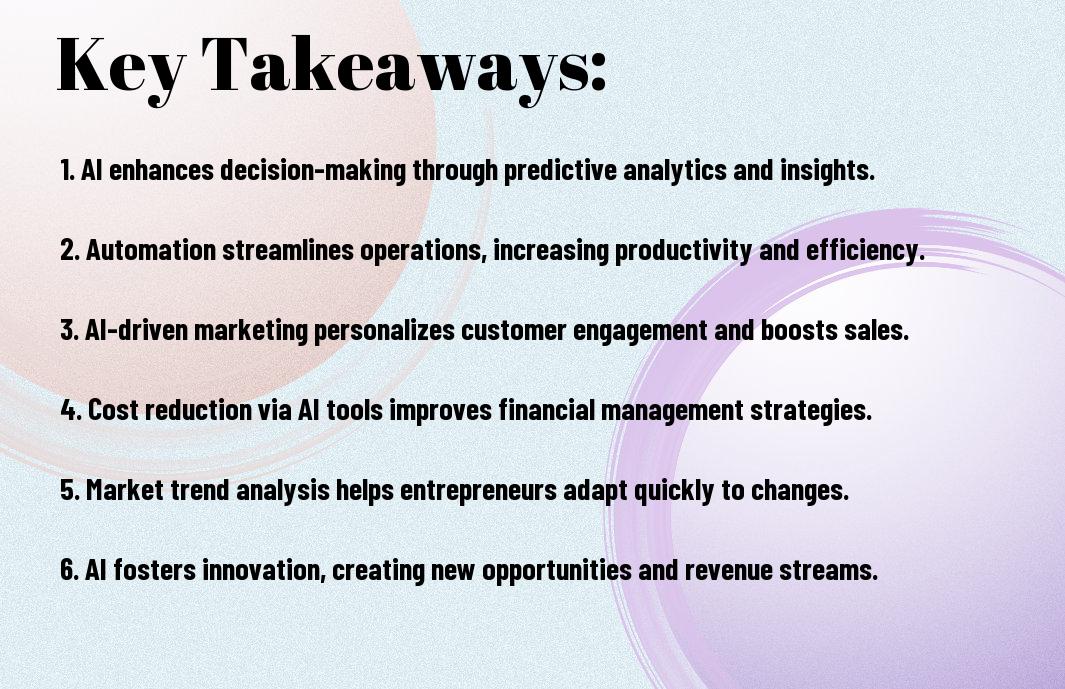As you navigate the ever-changing business landscape, you’re likely aware of the significant impact artificial intelligence (AI) is having on various industries. You may be wondering how AI innovations can drive growth and wealth for your business. With AI transforming the way companies operate, you have the opportunity to leverage these advancements to stay ahead of the competition and boost your bottom line. Your ability to adapt and innovate will be key to unlocking new opportunities and achieving success in this digital era.

Key Takeaways:
- Digital disruption driven by AI innovations is transforming the business landscape, creating new opportunities for wealth and growth through increased efficiency, improved decision-making, and enhanced customer experiences.
- AI-powered technologies such as machine learning, natural language processing, and computer vision are enabling businesses to automate processes, gain valuable insights, and develop innovative products and services that drive competitive advantage.
- Embracing AI innovations can help businesses stay ahead of the curve, drive innovation, and achieve sustainable growth, but it also requires a strategic approach to implementation, talent acquisition, and continuous learning to maximize the benefits of digital disruption.
The AI Revolution in Business
For businesses, embracing AI innovations is no longer a choice, but a necessity to stay competitive. You will notice significant improvements in efficiency and productivity as AI automates routine tasks, freeing up your resources for strategic decision-making.
Machine Learning Applications
Contrary to traditional methods, machine learning applications enable your business to analyze vast amounts of data, identifying patterns and making predictions that inform your decisions. You can leverage this technology to personalize customer experiences, enhancing engagement and loyalty.
Predictive Analytics
Beneath the surface of AI lies predictive analytics, a powerful tool that helps you forecast market trends and customer behavior. You can use this insight to make informed decisions, mitigating risks and capitalizing on opportunities.
In addition, as you investigate deeper into predictive analytics, you will discover its potential to optimize your operations, from supply chain management to financial planning. You can use predictive models to simulate different scenarios, testing strategies and identifying the most effective approaches to drive your business forward.

Wealth Creation Through Automation
There’s no denying that automation is a key driver of wealth creation in today’s digital age. By leveraging AI innovations, you can streamline your business operations, increase productivity, and ultimately drive growth.
Cost Reduction Strategies
With the help of automation, you can identify areas where costs can be reduced, and implement strategies to minimize waste and optimize resources, leading to significant savings and increased profitability for your business.
Efficiency Optimization
An important aspect of automation is its ability to optimize efficiency, allowing you to focus on high-value tasks and improve overall performance, which in turn can lead to increased competitiveness and revenue growth for your business.
Cost savings achieved through automation can be reinvested in your business, enabling you to explore new opportunities, develop new products or services, and expand into new markets, ultimately driving your business forward and increasing your wealth.
Transformative Business Models
To stay ahead in the digital age, you need to adopt innovative business models that drive growth and wealth. This involves leveraging AI to create new revenue streams and enhance customer experiences, allowing you to stay competitive in a rapidly changing market.
Platform Economies
Businesses like yours are leveraging platform economies to create new opportunities for growth and expansion. By connecting buyers and sellers, or offering services through a platform, you can increase your reach and revenue, while also providing value to your customers.
Subscription-Based Services
Platform owners like you are turning to subscription-based services to generate recurring revenue and build loyal customer bases. This model allows you to offer ongoing value to your customers, while also providing a predictable income stream for your business.
A key aspect of subscription-based services is the ability to collect and analyze customer data, allowing you to refine your offerings and improve customer satisfaction. As you consider implementing a subscription-based model, you should think about how you can use data to drive growth and enhance your customers’ experiences, ultimately leading to increased loyalty and revenue for your business.
Data as Currency
Your business’s data is a valuable asset, and leveraging it effectively can drive growth and wealth. By harnessing the power of data, you can gain insights, make informed decisions, and stay ahead of the competition.
Big Data Monetization
Above all, big data monetization is about turning your data into a revenue stream. You can achieve this by analyzing and processing large datasets to uncover hidden patterns and trends, and then using this information to develop new products or services.
Privacy Considerations
On the other hand, as you collect and utilize more data, you must consider the privacy implications. You need to ensure that your data collection and usage practices are transparent and secure, and that you are complying with relevant regulations.
Due to the sensitive nature of personal data, you must prioritize its protection and handle it with care. You should implement robust security measures to prevent data breaches and unauthorized access, and be prepared to respond quickly in case of an incident, to maintain trust with your customers and protect your reputation.
Investment Opportunities
All signs point to AI as a key driver of business growth, and you can capitalize on this trend by exploring investment opportunities in AI-driven companies. You can learn more about How AI Can Drive Innovation in Your Industry | HBS Online to gain insights into the potential of AI innovations.
AI Startups
Along with the rise of AI, you’ll find numerous AI startups that are revolutionizing various industries, and you can consider investing in these innovative companies to diversify your portfolio and potentially reap significant returns.
Legacy Company Transformations
Against the backdrop of digital disruption, you’ll notice that many legacy companies are transforming their business models to incorporate AI, and you can invest in these companies as they navigate this transition and potentially uncover new opportunities for growth.
Plus, as you consider investing in legacy company transformations, you’ll want to look for companies that are not only adopting AI technologies but also fostering a culture of innovation, allowing them to stay competitive in a rapidly changing business landscape, and you can position yourself for long-term success by investing in these forward-thinking companies.
Competitive Edge Factors
Once again, you need to focus on key elements that drive your business forward. Some of these factors include:
- AI-driven insights
- Innovative marketing strategies
Perceiving these elements as vital to your growth will help you stay ahead of the competition.
Speed to Market
For your business to thrive, you must be able to quickly adapt to changing market conditions and get your products or services to market faster than your competitors, allowing you to capitalize on new opportunities and stay ahead.
Adaptability Metrics
By monitoring your adaptability metrics, you can gauge your ability to pivot when necessary, and make data-driven decisions to drive your business forward, ensuring you stay competitive in a rapidly changing landscape.
Considering your adaptability metrics, you can identify areas where you need to improve, such as response time to customer feedback or the speed of implementing new technologies, and make targeted changes to increase your agility and responsiveness, ultimately driving your business growth and success.
Summing up
Summing up, you now understand how digital disruption and AI innovations are transforming your business landscape, driving wealth and growth. You can leverage these advancements to stay ahead, enhancing your operations and decision-making. Your ability to adapt and innovate will be key to unlocking new opportunities and achieving success in this rapidly evolving environment, enabling you to thrive in a future driven by technology and innovation.
FAQ
Q: What is digital disruption and how is it impacting businesses today?
A: Digital disruption refers to the transformation of traditional business models and processes through the adoption of digital technologies, such as artificial intelligence (AI), blockchain, and the Internet of Things (IoT). This disruption is impacting businesses in various ways, including changing consumer behavior, creating new revenue streams, and increasing operational efficiency. As a result, companies must adapt to these changes to stay competitive and drive growth.
Q: How is AI driving wealth and business growth in the digital age?
A: AI is driving wealth and business growth by automating processes, enhancing customer experiences, and providing data-driven insights to inform business decisions. AI-powered technologies, such as machine learning and natural language processing, are being used to improve operational efficiency, reduce costs, and create new products and services. Additionally, AI is enabling businesses to tap into new markets and customer segments, leading to increased revenue and profitability.
Q: What are some of the key AI innovations that are driving digital disruption in various industries?
A: Some of the key AI innovations driving digital disruption include chatbots and virtual assistants, predictive analytics and machine learning, computer vision and image recognition, and natural language processing and speech recognition. These innovations are being applied in various industries, such as healthcare, finance, retail, and manufacturing, to improve efficiency, reduce costs, and enhance customer experiences. For example, chatbots are being used in customer service to provide 24/7 support, while predictive analytics is being used in healthcare to diagnose diseases earlier and more accurately.
Q: How can businesses harness the power of AI to drive growth and stay ahead of the competition?
A: To harness the power of AI, businesses should start by identifying areas where AI can add value, such as improving operational efficiency or enhancing customer experiences. They should then invest in AI technologies and talent, and develop a strategy for implementing AI solutions. Additionally, businesses should focus on building a culture of innovation and experimentation, and be willing to take calculated risks to stay ahead of the competition. It’s also imperative to consider the ethical implications of AI and ensure that AI systems are transparent, explainable, and fair.
Q: What are the potential risks and challenges associated with adopting AI and how can businesses mitigate them?
A: The potential risks and challenges associated with adopting AI include job displacement, bias in AI decision-making, and cybersecurity threats. To mitigate these risks, businesses should invest in employee retraining and upskilling programs, ensure that AI systems are designed and tested to avoid bias, and implement robust cybersecurity measures to protect against AI-powered attacks. Additionally, businesses should establish clear governance and oversight structures to ensure that AI systems are aligned with business goals and values, and that their use is transparent and accountable. By being aware of these risks and taking steps to mitigate them, businesses can minimize the potential downsides of AI adoption and maximize its benefits.











